-
-
Yoga Courses
Yoga Teacher Training India
Yoga Teacher Training Canada
Yoga Teacher Training Germany
Yoga Teacher Training Greece
Yoga Teacher Training Portugal
-
Yoga Retreats
-
YTTC Guide

Experience two transformative months full of inspiration and challenge. Our 500 hour Yoga Teacher Training in Bali combines the foundational 200 hour YTT, where you’ll learn the essentials of becoming a Yoga teacher, with an advanced 300 hour training.
The program is divided into two semesters, each designed to build upon the previous learning. After completing the first semester, there is a ten-day break, providing you with the opportunity to rest and internalize the information you’ve learned, and explore the island’s natural beauty and cultural richness.





The first part of the training focuses on different Yoga styles, including traditional Hatha Yoga, Hatha Flow, and Vinyasa Yoga. You’ll learn the fundamental principles and techniques of each style, gaining a comprehensive understanding of their unique benefits and applications. These three weeks provide a solid base for your practice and teaching journey.
This part of the training is designed to expand your practice and deepen your understanding of Yoga. Here we will dive deeper into Ashtanga Vinyasa and arm balancing. Chakra meditation is another key component of this training, guiding you through techniques to balance and align your energy centers, promoting overall well-being and heightened awareness. The study of the Hatha Yoga scriptures will enrich your philosophical and spiritual knowledge, offering a deeper context for your physical practice.
Over two intensive months of dedicated and disciplined practice, you’ll have the opportunity to deepen your knowledge and skills. This experience will lead to a profound shift in how you see yourself and the world, ultimately transforming your life.
We offer a place where you can find happiness through movement, pranayama, meditation and well-balanced nutrition. We are here to guide you on your spiritual journey, to connect with your Inner-Self and to find contentment and peace in life.
Throughout the course, you’ll engage in intensive practice sessions, interactive workshops, and detailed lectures. These elements are designed to challenge you, fostering personal growth and professional development. By the end of the 500 hour yoga teacher training Bali, will not only have all the tools you need to guide your students through a well-designed and safe yoga class , you will also have knowledge in more specialized topics, ready to inspire and lead others with your enhanced expertise.
Throughout this 500 hour Yoga TTC in Bali we will take a journey through the rich history and profound philosophy of Yoga. We will begin with the foundational texts and gradually explore more complex philosophical concepts, providing a comprehensive understanding of yoga’s evolution and its relevance today.
Etymology and Definition of Yoga: Learn where the word “yoga” comes from and how it has been defined over the course of history.
Aims and Objectives of Yoga: Understand the primary aims of yoga and the specific objectives it seeks to achieve for physical, mental, and spiritual well-being.
Yoga Eras: Explore the different historical eras of yoga, from its origins in ancient texts to its classical formulations and modern adaptations.
Paths of Yoga: Study the various paths of yoga, including Karma Yoga, Bhakti Yoga, Jnana Yoga, and Raja Yoga, and how each path offers unique approaches to spiritual practice and self-realization.
Patanjali Yoga Sutras (Yoga Darshan): A foundational text on the practice and philosophy of yoga that comprises 196 sutras and outlines the eight limbs of yoga (Ashtanga Yoga): Yama (ethical disciplines), Niyama (personal observances), Asana (postures), Pranayama (breath expansion), Pratyahara (withdrawal of senses), Dharana (concentration), Dhyana (meditation), and Samadhi (absorption).
Hatha Yoga Pradipika: A classical text on Hatha Yoga written by Swami Swatmarama in the 15th century that describes physical practices (asanas), breathing techniques (pranayama), and purification methods (shatkarmas) essential for preparing the body for higher spiritual practices.
Gheranda Samhita: Another significant text on Hatha Yoga, attributed to the sage Gheranda that emphasizes a seven-fold path to purification and transcendence of the body and mind.
We are blending historical and philosophical knowledge with practical applications so that you will gain a holistic perspective that enriches your practice and teachings.
Variety of Yoga Asana Styles
You will get the chance to practice different styles of Yoga asana. Apart from traditional Hatha Yoga, we teach Ashtanga Vinyasa and more modern styles like Hatha Flow, Vinyasa Flow, and Arm balancing. We also have Yin Yoga classes, but they are for your own practice only. If you would like to learn more about Yin Yoga and be able to teach it, you can join our 50 hour Yin Yoga training.
Focus on Personal Practice
The main focus in these classes is your own practice. We encourage you to use this training to deepen your own Yoga practice. Cultivating a regular self-practice will be the foundation of all your teaching.
Transformation Through Continuous Practice
After practicing continuously for two months, you will see a huge transformation in your life. It is a wonderful opportunity to integrate tapas – austerity – into your life.
In our asana alignment classes we will then dive deeper into the art of teaching asana. You will learn
~ How to perform different Yoga postures
~ How to integrate conscious breath awareness
~ The benefits and precautions of each asana
~ How to use props like blocks and belts correctly
~ How to cue your students to get into the postures
~ How to use hands on adjustment under consideration of your students un
After building the foundation in the first month we get into more advanced asanas in the second half of the training.
Ashtanga Vinyasa is part of the Hatha Yoga system and consists of six fixed series with a set order of asanas. We cover the Primary Series and you will be introduced into the art of teaching Ashtanga Vinyasa. We include both Mysore and Led classes. In the second half of the course we will practice in Mysore style 5 days per week and on the 6th day we practice a led class. This allows you to practice in your own pace and according to your experience and to become familiar with both teaching styles.
You will learn
~ Sanskrit counting
~ Drishti in the asanas
~ The importance of Ujjayi breath during the practice of Ashtanga Vinyasa
~ How to do Vinyasa flow (with jumping back and front)
~ How to do Chakrasana (rollback)
~ How to go from Hasta Uttanasana into Chakrasana and stand back up into Hasta Uttanasana
We will break down the asanas of the Primary Series and you will learn the alignment and the flow of the poses included.
Opening Mantra
Surya Namaskar A (5 rounds)
Surya Namaskar B (5 rounds)
Standing postures
Sitting postures
Finishing postures
Savasana
Closing Mantra
We have a special module to dive deeper into the world of arm balances. This section is designed to give students with the skills and knowledge needed to master these challenging yet invigorating poses.
A sneak peek of what students will learn:
Some asanas included:
You will learn the complete sequence of 48 yogic exercises created by Sri Dhirendra Bhramchari to activate the pranic body and detoxify and nourish your joints.
These small movements aligned with breath are very powerful in sharpening the senses and developing willpower and strength.
Chakras are energy centers in our body. They are junction points where the different nadis meet and represent a connection between our physical and astral body. We have seven main chakras in our body along our spinal cord.
The way we live our lives nowadays often results in energy blockages and can lead to physical and mental disturbances and diseases. Chakra meditation is a powerful source to activate and purify our chakras. When all chakras are open, turning and glowing, there are no blockages in the physical, mental and spiritual areas. We feel energetic, stable and in our center.
You will learn to use different meditation techniques, asanas and sequences for each chakra to unfold its potential.
You get the chance to practice some of the six Kriyas used to purify the body and prepare it for a successful Yoga practice.
You will learn the benefits and precautions of all the Shatkarmas and how to perform them in a safe way to clean and purify your body.
~ Dhauti – Danta Dhauti, Antar Dhauti, Hrid Dhauti, Moola Shodhana Dhauti
~ Vasti – Jal and Sthal
~ Neti – Jal and Sutra
~ Trataka – Bahir trataka , Antar trataka, Adho trataka
~ Nauli – Uddiyana Bandha, Dhyana Nauli, Vama Nauli, Daksina Nauli
~ Kapalbhati – Vatakrama kapalabhati, Vyutkrama kapalabhati, Sheetkrama kapalabhati
What is the difference to breathing practice and pranayama? In this module we will teach you different breathing techniques and introduce you to the art of pranayama – breath expansion.
Breathing
~ Natural breathing
~ Abdominal breathing
~ Thoracic breathing
~ Clavicular breathin
~ Yogic breathing
You will learn different variations of each pranayama technique and get familiar with the pranayamas mentioned in the Hatha Yoga scriptures.
~ Suryabhedana
~ Ujjayi
~ Sheetkari
~ Shitali
~ Bhastrika
~ Bhramari
~ Murcha
~ Plavini
~ Sahit Pranayama (Sagarbha, Nigarbha)
~ Suryabheda
~ Ujjayi Pranayama
~ Sheetali Pranayama
~ Bhastrika Pranayama
~ Bhramari Pranayama
~ Murchha (Unconsciousness) Pranayama
~ Kevali Pranayama
The meditation module in our 500 hour yoga teacher training Bali consists of both theory and practice classes.
You will learn:
~ The 12 steps of meditation
~ Foods that help improve focus
~ The ideal time and place for meditation practice
Additionally, the module covers:
Basic techniques of meditation
~ Benefits of meditation
~ Mindfulness practices
Every day we will practice meditation together for you to deepen your practice and experience different mediation techniques.
You will also practice and learn the concept of chakra meditation. Chakra meditation is a powerful source to activate and purify the chakras and you can use it for your own practice and your classes.
Mudras are higher practices that lead to awakening of the pranas, chakras and kundalini. They can give major siddhis, psychic powers, to the advanced practitioner. Usually, mudras are introduced after some proficiency has been attained in asana, pranayama and bandha, and gross blockages have been removed.
We will introduce you to the five classes of mudras and teach you several hand mudras and their effects.
~ Anjali Mudra
~ Jnana Mudra
~ Chin Mudra
~ Dhyana Mudra
~ Prana Mudra
~ Apana Mudra
~ Vayu Mudra
~ Akasha Mudra
~ Prithivi Mudra
~ Varuna Mudra
~ Agni Mudra
~ Ganesha Mudra
~ Surbhi Mudra
~ Asthma Mudra
~ Pankaj Mudra
~ Kubera Mudra
~ Shankh Mudra
~ Garuda Mudra
~ Jal Shaamak Mudra
~ Yoni Mudra
~ Linga Mudra
Every day we are going to chant different mantras together. You might have already experienced the power of certain mantras and how they resonate with you. We will teach you different mantras and their power. We will give you time to practice and repeat the mantras together regularly so that they can settle and unfold their potential.
Mantras you will learn:
~ OM
~ Ganesha Mantra
~ Shivaya Mantra
~ Rama Mantra
~ Shanti Mantra
~ Gayatri Mantra
~ Maha Mrityunjaya Mantra
~ Anapoorna Mantra
~ Patanjali Mantra
~ Ganesha Vakratunda Mantra
~ Guru Mantra
~ Maha Mantra
~ Om Asatoma Sadgamaya Mantra
Nutrition plays a major role in the yogic lifestyle. The food we consume has a tremendous effect on our health and the quality of our yoga practice. Ancient yogis were already aware of that and designed the “Yogic diet”. You will study the different qualities of food and the effects they have on your body; the components of the yogic diet and how to incorporate it in your life.
Ayurveda is the knowledge of life, over 5000 years old and one of the oldest medical systems on earth. In the second half of the 500 hour teacher training Bali we would like to give you an insight in this fascinating philosophy.
India’s ancient health system offers so much wisdom for living a healthy and happy life and we are looking forward to sharing some of this knowledge with you.
~ Introduction to Ayurveda
~ Branches of Ayurveda
~ Five Elements
~ Tri Dosha: Vata, Pitta & Kapha
~ Sapta Dhatus
~ Tips to Balance the three doshas
~ Balancing Diet for Tri Dosha & Six Tastes
~ Improvement of digestion and health
~ Daily routines, seasonal routine and exercises
~ Tips for air travel
It is important to know how the different Yoga practices affect the physical body. In our anatomy and physiology classes we give you an introduction into how the human body is build and how it functions. We will teach you how different systems work together and how they are affected by asana, pranayama and meditation practice.
You will learn about
~ Structural design of the human body
~ Musculoskeletal system
~ Hip anatomy
~ Spine anatomy
~ Core Anatomy
~ Nervous system
~ Cardiovascular system
~ Respiratory system
~ Arm and shoulder anatomy
~ Anatomical patterns in arm balances
~ Anatomical patterns in forward bends, back bends and twists
Discover the secrets behind the art of teaching Yoga. Ever wondered how your teachers flawlessly flow from one asana to another? In our teaching methodology module, you’ll master the skill of sequencing and designing a perfectly balanced Yoga class.
Here is just a glimpse of what you will learn:
At the end of the first month, you get the chance to teach your first Yoga class in the style of your choice (Hatha Yoga, Hatha Flow or Vinyasa).
The time schedule is not fixed and can change according to location, teacher availability, weather conditions and general situation.
Shatkarma | 06:30 to 06:45 am |
Pranayama/Meditation | 06:45 to 07:45 am |
Yoga asana practice | 07:45 to 09:15 am |
Breakfast | 09:15 to 10:15 am |
Yoga theory/Anatomy & physiology | 10:15 to 11:45 am |
Asana Alignment | 11:45 to 01:30 pm |
Lunch | 01:30 to 03:15 pm |
Yoga philosophy | 03:15 to 04:45 pm |
Teaching practice | 05:00 to 06:30 pm |
Mantra Chanting | 06:30 to 07:00 pm |

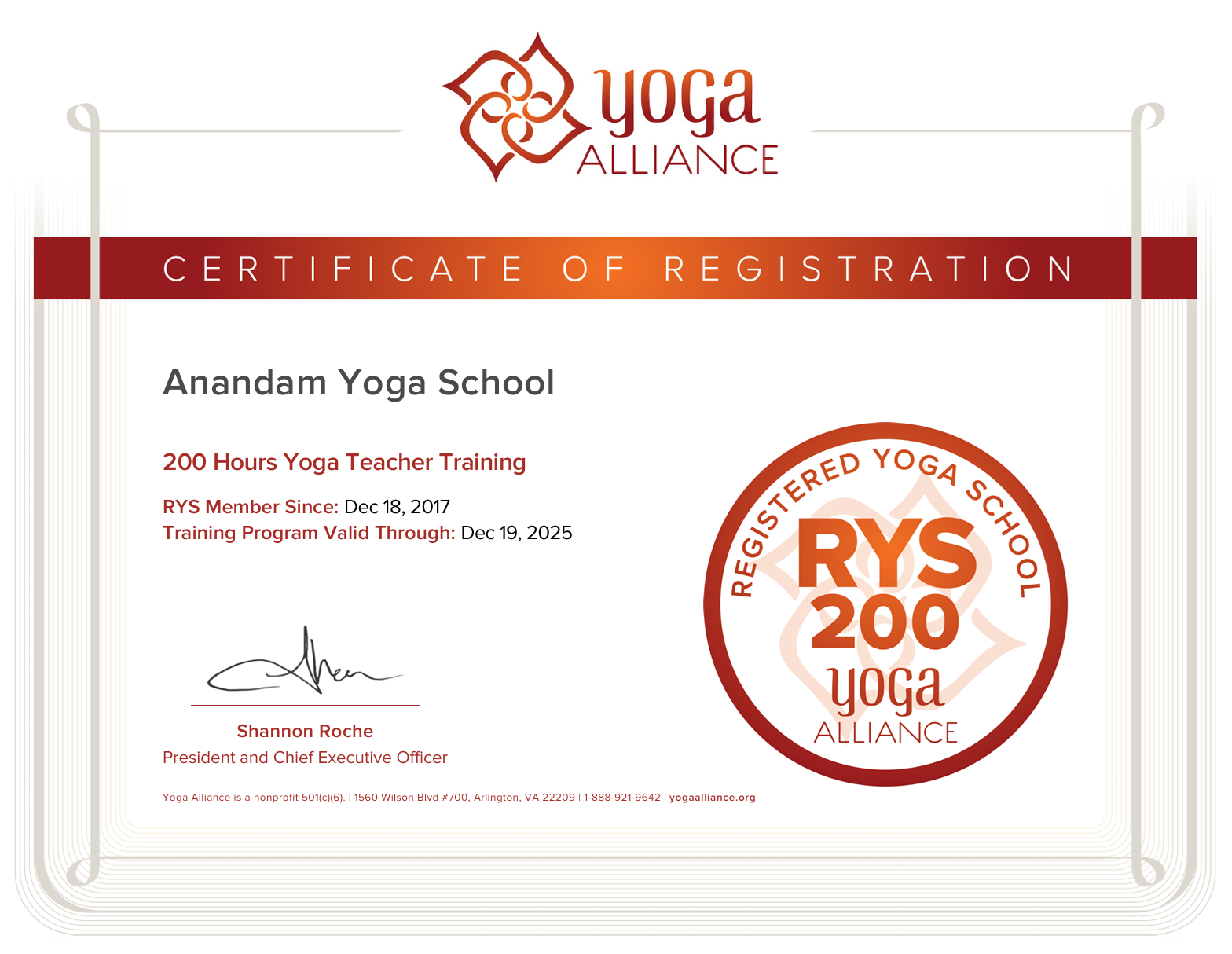


Posted onTrustindex verifies that the original source of the review is Google. I did my 200YTT with Anandam Yoga School in August in Bali and it was an exceptional experience. Navin and Ming guided us through the course and shared their valuable yoga experience and knowledge with us. Katharina’s anatomy classes perfectly linked the facts to the yoga practice. She also provided a detailed and very well- structured course manual which I still keep consulting. I enjoyed the course very much, could improve my own practice, deepen my knowledge and prepare myself for a step forward to become a yoga teacher. I am thinking of doing some other training courses with Anadam Yoga School in the future. Thank you, Anandam Yoga School team:-)Posted onTrustindex verifies that the original source of the review is Google. I completed my 200h YTT in 2025, and it was truly a transformative experience. While the classes sometimes felt overwhelming, everything gradually fell into place, and the journey continues well beyond the training itself. A heartfelt thank you to the teachers who made this possible: ✨ Navin, for teaching from his heart, his ability to break down asanas and provide encouragement when it got tough. ✨ Katharina and Bhavna, for making anatomy classes engaging and accessible. The training was more than getting stronger physically - it was wholesome and encouraged self-discovery and inner growth.Posted onTrustindex verifies that the original source of the review is Google. I had an incredibly beautiful week at Heimbach in Germany while taking part in the Yoga Nidra Teacher Training. Sandeep and Katharina are very good and really nice teachers with a lot of knowledge of and experience with authentic yoga. I am happy that they shared this with me and I feel that this made me grow in my yoga path. This, added to the positive atmosphere they created during the training, made this week an unforgettable experience!Posted onTrustindex verifies that the original source of the review is Google. I had a wonderful week of yoga Nidra teacher training at Heimbach in Germany. Beautiful location located in the green hills of the Eifel. Learning from Sandeep and Katharina was very precious, they have so much knowledge about and experience with what true yoga is. And they create such a nice athmosphere with their beautiful personalities as well! I had an amazing week!Posted onTrustindex verifies that the original source of the review is Google. J’ai suivi en avril 2025 la formation de 200 heures avec Navin, Ming et Katerina et j’en ai eu une expérience très positive. Les cours de yoga de Navin et Ming m’ont aidé à progresser dans les postures. Merci à Katherina pour ses cours d’anatomie compréhensibles pour des élèves dont l’anglais n’est pas la langue maternelle. Je ne peux que recommander cette formation pour toute personne qui souhaite approfondir ses connaissances sur le yoga dans le but ou pas de l’enseigner.Posted onTrustindex verifies that the original source of the review is Google. I had the most wonderful experience with Anandam Yoga School! I enrolled myself for the 200hours yoga teacher training course in April 2025 and it was the most transformative experience I had so far. Navin and Ming gave us alot of guidance in asanas practices and the long history of yoga. Also Katharina provided us with an in-depth knowledge about human anatomy. I will definitely enrol myself with Anandam yoga school in the future to enrich myself!Posted onTrustindex verifies that the original source of the review is Google. J’ai réalisé le 200h YTT avec Anandam à Bali. L’expérience était extraordinaire et très enrichissante. Les profs sont supers. Au-delà de la formation, j’ai beaucoup appris sur moi même, pris confiance en moi et en mes capacités. Je pense faire le 300h YTT également avec cet organisme !Posted onTrustindex verifies that the original source of the review is Google. I had a beautiful experience at Anandam Yoga School. Naveen, Katharina and Sandeep were wonderful teachers. They are so kind and always allow for an atmosphere to feel safe in your vulnerability. The YTT is always an experience where people are learning and growing physically, mentally, emotionally and spiritually. My yoga teachers always allowed for this growth whilst supporting us when we made mistakes or found poses hard, for example. The YTT here was a truly precious experience for me and one I will hold in my heart. I loved the authenticity and the way we could connect to the yoga philosophy and spirituality of yoga - which is what makes yoga yoga. There was an emphasis on teaching traditional yoga which is incredibly important and I appreciated this a lot. Thank you for my wonderful teachers for their kindness and calmness throughout my journey. The YTT created an opportunity for self-discovery that I truly valued. I enjoyed socially learning about yoga with a lovely group of people. I found depth in my connection with the spirituality of yoga in my solitude and had a real opportunity for self-reflection and empowerment with the YTT. I would definitely recommend it to anyone considering YTT. I am still in touch with Naveen, Katharina and Sandeep and am sure our paths will cross via yoga or friendship again at some point in our lives. Lots of love to you, Bhawna 🤍Posted onTrustindex verifies that the original source of the review is Google. I recently completed the 200-hour Yoga Teacher Training with Anandam, and it was one of the most beautiful gifts I’ve ever received in my life. My intention going into the course was to expand my understanding of the yogic philosophy, anatomy, and deepen my personal asanas practice— I walked away with everything I hoped for, and more than I could have imagined. The environment Sandeep and Katharina created allowed us to really dive deep —physically, mentally, and spiritually. If I had to sum up the experience in one word, it would be authentic. Every aspect of the training, from the teachings to the community, was rooted in true yogic history & values. The teachings themselves were structured, disciplined and methodical, yet delivered in a way that felt accessible and not intimidating. I’m the kind of person who loves to ask a million questions, and all of the teachers so happy to engage (even when I thought i might be being annoying!) Amidst all the learning, there was also so so much playfulness, fun, and laughter. It made the experience feel lighthearted, joyful, and full of connection. Beyond the course completion, the supporting materials we received have been invaluable -they're tools I continue to reference almost daily. Meeting and learning from Sandeep and Katharina, (& Nadeem & Ming) was transformative, and I’m beyond grateful to have had the opportunity to learn and grow in such a supportive environment from such beautiful, knowledgeable & grounded people. <3Posted onTrustindex verifies that the original source of the review is Google. Dear Katharina, dear Sandeep, dear Navin, dear Ming - you wonderful teachers! A heartfelt thank you for all the new knowledge, your experiences you shared with us and the loving space you have created to meet all these wonderful people in our small group of the 200hour teacher training! I loved the atmosphere, I loved the place, I loved the togetherness and of course I loved the pool to cool down 😅 in hot Bali!
We genuinely value direct bookings with us as they help us provide you with the best possible experience. Please note that we have changed our course venue for 2025. The pictures below show the new venue and accommodation options.
Early Bird are special prices for the first 6 registrations per month. Register now to benefit from this special offer.

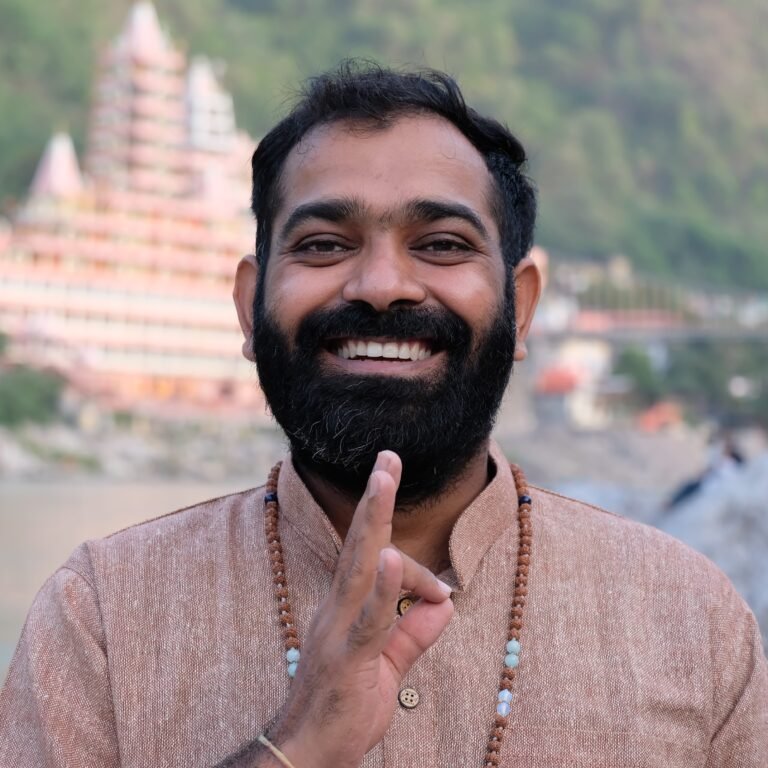
Lead Teacher
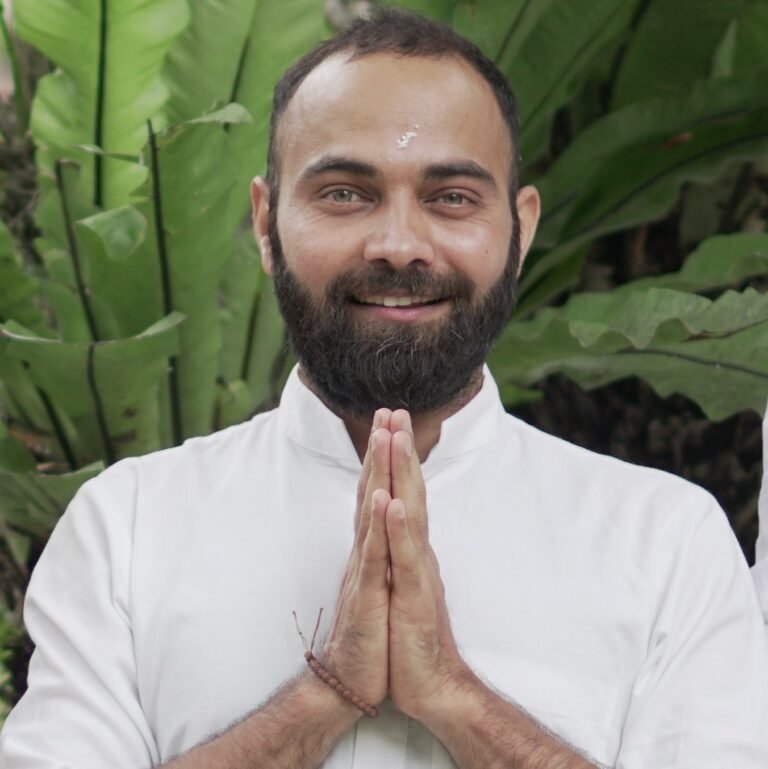
Lead Teacher
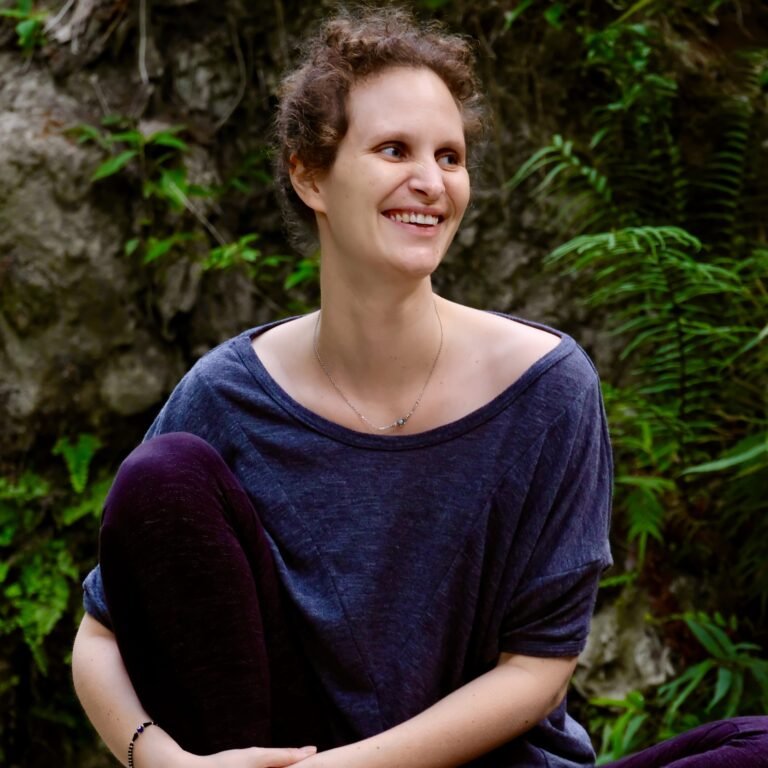
Lead Teacher
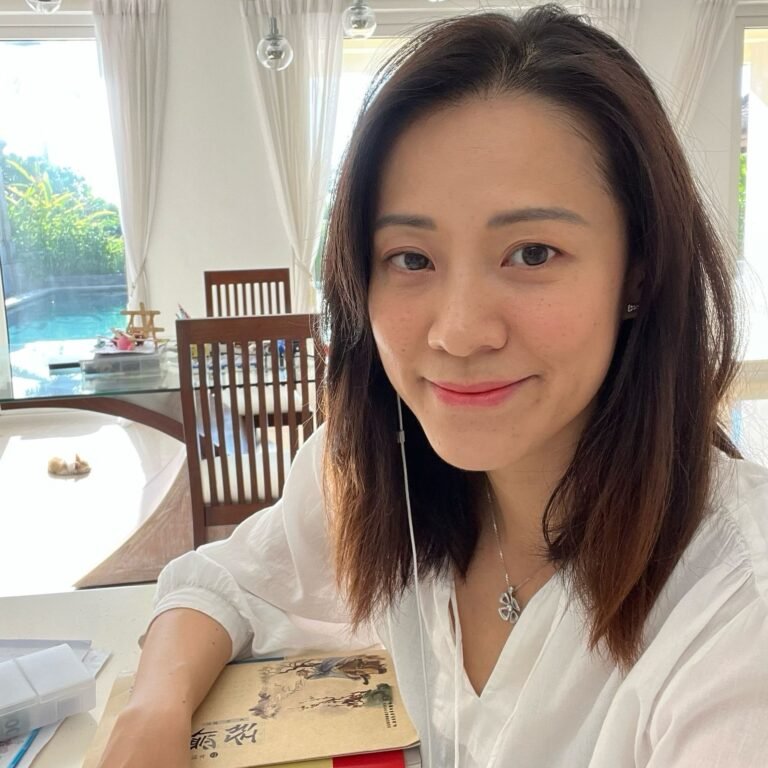
Lead Teacher

Being a Yoga teacher is more than showing poses. It’s about guiding others with compassion on their journey to a better life.

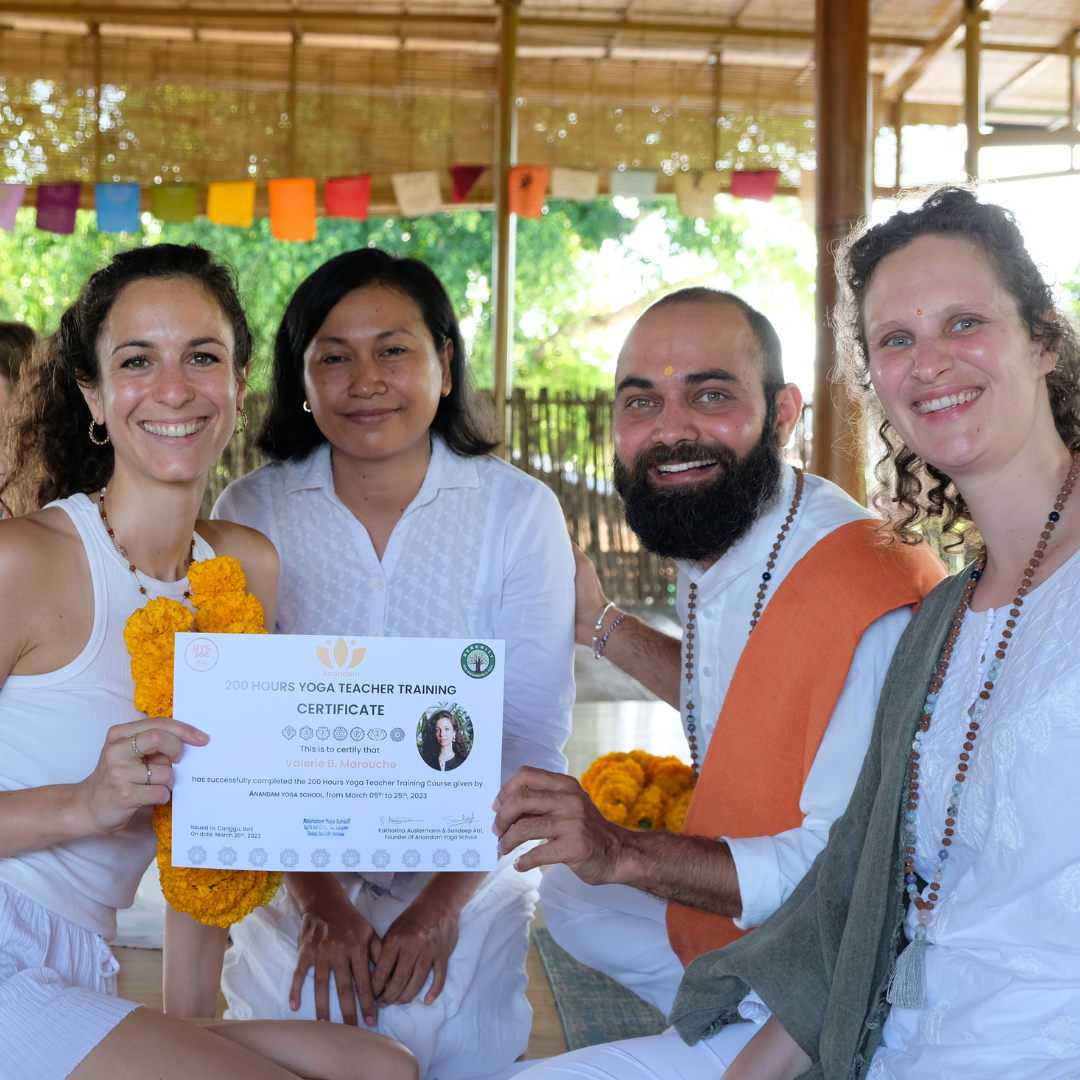





Yes, this course is suitable for all experience levels. If you are a beginner it is a wonderful way to start your Yoga journey from the base and create a strong foundation. This 500 hour Yoga teacher training is a blend of our foundational 200 hour Yoga teacher training and our advanced 300 hour Yoga teacher training. It will equip you with everything you need to start your Yoga path and to deepen your practice and teaching.
Our average class size is 5 to 10 students. We believe in individualized support thus the smaller group size. It allows us to support every student on their personal Yoga journey.
The youngest student we had was 18 and the oldest student we had so far was 60. So, we have quite a wide age range, which beautifully allows Yoginis and Yogis of different ages to learn from each other.
Yes, definitely! It is a beautiful way to deepen your own practice and learn more about the roots of Yoga and experience a deep immersion into the yogic practices.
We offer different course packages. You can choose to stay with us or find you own accommodation. The basic course fee (without accommodation) includes all study materials, Yoga Alliance certification after successful completion and daily breakfast. You can choose from different course and accommodation packages if you choose to stay with us.
In our training, we slowly open and strengthen the physical body allowing you to gradually increase strength and flexibility throughout the training. Yoga is a cleansing and purification process as well, thus it is likely that you are being challenged during the course on different levels (physical, mental, emotional), but not in regards to physical over-exertion.
This training is a combination of our 200 hour Multi-style Yoga teacher training, including Hatha Yoga, Hatha Flow and Vinyasa Flow and our advanced 300 hour Yoga teacher training focused on Ashtanga Vinyasa and arm balancing.
The nearest airport is I Gusti Ngurah Rai International Airport in Denpasar. From there you can book a grab or gojek to reach the course venue (250 k – 300 k IDR). You can download the apps and they are a great to get around in Bali for reasonable prices. You can get a sim card at the airport.
Please bring comfortable, ideally light cotton clothes for the practice; white clothes for the opening and closing ceremonies; natural mosquito repellent; beach towels; your everyday toiletries; light and airy clothing; sunscreen and all you think you need for a wonderful time in the tropical Bali.
Yes, sure! We don’t have any dietary restrictions during our Yoga teacher training. However, we recommend to adhere to a vegetarian diet during the Yoga teacher training Bali, to feel the effects on body and mind.
Practice Yoga regularly, drink enough water, try to cultivate a positive and open mindset, try to get enough rest and take time for relaxation.
To reserve your spot in the course we kindly ask you to deposit $500. This deposit is non-refundable. In case you have to cancel the training for any reason, the deposit can be applied to a later training.
Yes, this 500 hour Yoga teacher training is registered with Yoga Alliance and you will receive a Yoga Alliance affiliated certificate after successful completion. With this certification you can register with Yoga Alliance as a RYT-500 (Registered Yoga teacher – 500 hours) and you can teach Yoga internationally.

Being a Yoga teacher is more than showing poses. It’s about guiding others with compassion on their journey to a better life.

Being a Yoga teacher is more than showing poses. It’s about guiding others with compassion on their journey to a better life.